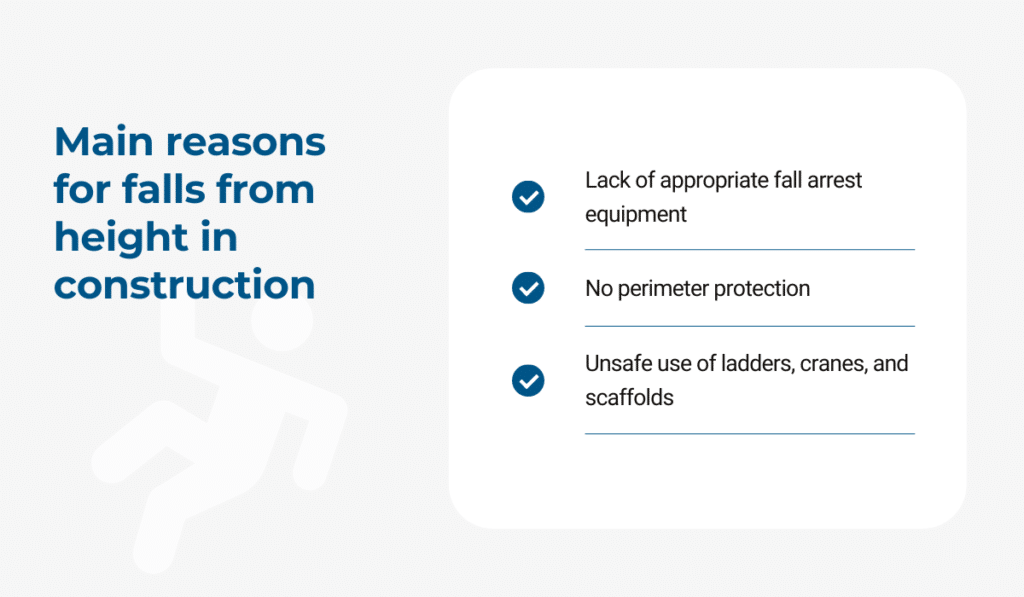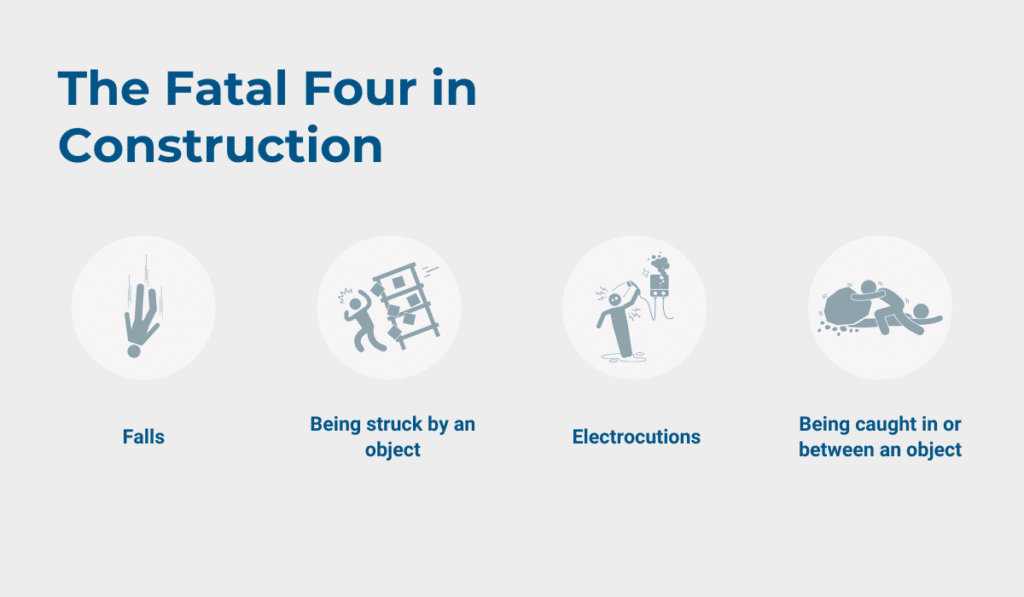A construction site can be quite a dangerous place to work.
Working with heavy machinery often invites disaster. The slightest error or lack of attention on the site can lead to severe injuries.
In light of this, it is the responsibility of site managers and construction business owners to understand the dangers on construction sites and do everything in their power to prevent them from happening.
To help you out, we’ve gathered the most essential statistics on construction site injuries.
In this article...
The Number of Injuries in the Workplace Remains Unchanged Since 2018
The US Bureau of Statistics report confirmed that the total number of work-related injuries has remained the same since 2018.

Currently, there are 2.8 injuries per 100 workers every year.
The number of injuries in the private sector also remains consistent, with approximately 2.8 million injuries and illnesses happening every year.
The same report has found that 0.9 of work-related injuries per 100 full-time employees require taking days off from work.
Businesses will have to implement new solutions to reduce the number of those injuries.
The Number of Fatalities in Construction Dropped in 2020
In 2020, there were 39 fatal injuries in the construction sector, which is a drop from 42 in 2019.
Although there were fewer incidents resulting in deaths, the number is still concerning, as there are more fatal injuries in construction than in other similar industries.
For instance, agriculture, forestry, and fishing recorded 34 and manufacturing 20 fatal injuries, respectively.
It’s important to mention that the ongoing pandemic has made it difficult to get an accurate assessment of the number of injuries.
Since many contractors spent considerable time away from work last year, it’s possible that there would have been more fatal accidents on construction sites if the pandemic hadn’t discontinued operations.
While the declining number of deaths in construction is most welcome, vigilance is still required.
20% Of Deaths in the Private Sector in 2019 Happened in Construction
Data from the US Bureau of Labor reveals that 20% of all deaths in the private sector occur in the construction industry.
This means that the construction industry accounts for about 1 in 5 deaths of workers in the private sector every year. In 2019, a total of 1061 fatalities were recorded in the private construction industry.
The data suggest that construction work is still one of the riskiest occupations in terms of workplace safety.
Private contracting organizations will have to increase their efforts if they are to eliminate tragic incidents. Besides complying with necessary regulations, companies should actively invest in solutions that improve construction site safety.
More Than 11.5 Billion Dollars Is the Total Annual Cost of Construction Injuries Across the United States
A comprehensive scientific study has found that construction injuries incur a cost of $11.5 billion every year.
It’s alarming that contractors represent only 5% of US private-sector workers, yet their work-related injuries account for 15% of all private industry costs. Construction workers disproportionately suffer injuries, which represents a financial strain on their employers as well.
What is more, out of the $11.5 billion spent on construction injuries, about $4 billion or 40% was allocated to fatalities, and the rest on non-fatal injuries.
However, while these numbers are shocking in their own right, another more recent study paints an even darker picture, estimating the total cost of work-related injuries in 2019 at $171 billion.
It’s important to note that the latter study aims to estimate the societal impact of those costs, and not specifically their effect on the companies themselves.
Nevertheless, if we assume that construction workers account for 15% of those injuries as well, in accordance with the previous study, then the estimated annual costs in the industry would total around $25 billion.
A Construction Worker With a 45-Year Career Has a 75% Chance of Experiencing a Disabling Injury
As construction workers get more advanced in age, they are far more likely to experience a disabling injury than their younger peers.
A study has found that contractors with a career spanning over 45 years have a 75% chance of suffering a disabling workspace injury. The study considered 20 years old to be the age at which most individuals enter the construction industry.

These findings were supported by a similar meta-study from PubMed Central, showing that the severity of the injuries suffered by construction workers is likely to increase over time because of their decreased ability to recover.
The study also reveals that physical disability is the most significant concern among senior contractors. This isn’t at all surprising when you keep in mind that the workers’ chances of experiencing a disabling injury increase the further along they are in their career.
47% of All Accidents in Construction Are Falls From Height
Falls from a height are the most common safety hazard in the UK construction industry.
A study estimates that, on average, falls from heights comprise 47% of all construction site accidents, followed by being trapped by collapsing objects (16%) and struck by moving objects (12%).
According to the US Bureau of Labor, in 2019, there were 1481 fatal injuries that occurred during transportation and material moving operations.
The same stats showed that transportation incidents increased by 2% since 2018, reaching the highest levels since 2011.

Therefore, without proper regard to safety protocols and adequate training, falls from heights are likely to occur. Some of the main reasons for construction site falls are:
- Lack of appropriate fall arrest equipment
- No perimeter protection
- Unsafe use of ladders, cranes, and scaffolds
Sadly, according to the same report, almost half of all falls from height are fatal. Fatal falls are more common in the construction industry than in any other profession.
Fall Protection in Construction Was the Most Violated OSHA Regulation in 2020
In spite of the sobering statistics about the prevalence of fatal falls in the construction industry, the Fall Protection regulation has been the most frequently violated OSHA regulation for 10 consecutive years.
In 2020 alone, there were 5424 recorded violations of this regulation.
The Fall Protection regulation requires contractors to implement protection systems across the worksite. These include fall arrest gear, guardrails, and safety nets to protect workers from falls.
Additionally, employers are obligated to provide safety equipment at no cost to the workers.
It’s mind-boggling that the most commonly violated regulation is the one responsible for preventing some of the most dangerous worksite accidents, yet contractors still struggle to comply with Fall Protection ordinances.
Transportation Incidents Caused the Most Fatal Injuries in 2019
According to the US Bureau of Labor, in 2019, there were 1481 fatal injuries that occurred during transportation and material moving operations.
The same statistic showed that transportation incidents increased by 2% since 2018, reaching the highest levels since 2011.
Transportation and material moving are essential operations for any construction site. They ensure that the construction site has a steady supply of materials necessary to complete the project.
However, if decision-makers neglect to take the necessary safety precautions, transportation operations can become hazardous for workers. When contractors transport or move heavy materials, it’s imperative that they do it in a safe and orderly manner.
Over 60 Percent of All Construction-Related Fatal Injuries Are Caused by Only Four Major Causes
The top four causes of fatal injuries in construction are referred to as the Fatal Four of construction.

According to data from the US Bureau of Statistics, they are:
- falls: 33.5% of construction worker deaths happen because of falls from heights.
- struck-by-object injuries: 11.1% of fatal injuries occur when a moving object strikes the worker
- electric shock: 8.5% of worker fatalities result from electrocutions, and the victims are typically younger workers
- caught in/between incidents: 5.5% of construction worker deaths occur when workers are caught in between materials, for instance, after a collapse
Since these incidents cause as much as 60% of all fatal injuries, complying with safety regulations on construction sites will be essential to reducing the fatal injury count.
Implementing a Safety Program Can Reduce Costs Related to Injury and Illness by up to 40%
Safety programs will continue to have a substantial role in reducing injury-related costs in the construction industry.
A report cites that implementing a safety program can reduce injury-related costs, including the costs of worker’s medical treatments and sick days up to 40%.
Many contracting companies might look at safety programs as a superfluous expense, but that view is incorrect.
Safety programs are an investment that ultimately increases company profitability. They save money in case of an injury-related cost and improve field worker productivity by keeping them safe.
Conclusion
Despite improvements in construction site safety, there’s still a long way to go to making construction work a low-risk occupation.
The statistics we covered today clearly show that serious worksite injuries are far from uncommon among construction workers in the private sector.
It’s up to site managers and construction companies to prioritize the safety of their employees.
Have your team members experienced injuries on construction sites? And if so, what measures are you taking to eliminate the safety risks?
Now that you understand the state of workspace safety in construction, it’s time to focus on implementing new solutions that address these problems.
REFERENCES
https://www.bls.gov/news.release/archives/osh_11042020.pdf
https://www.hse.gov.uk/statistics/industry/construction.pdf
https://www.hse.gov.uk/statistics/fatals.htm
https://www.osha.gov/data/commonstats https://www.ncbi.nlm.nih.gov/pmc/articles/PMC2491397/
https://injuryfacts.nsc.org/work/costs/work-injury-costs/
https://www.ncbi.nlm.nih.gov/pmc/articles/PMC7735369/
http://www.safetyandhealthmagazine.com/articles/construction-workers-experience-higher-rates-of-injury-premature-death-study-2
https://www.cpwr.com/wp-content/uploads/publications/Quarter2-QDR-2019.pdf
https://www.osha.gov/laws-regs/regulations/standardnumber/1926/1926.501
https://www.oshaeducationcenter.com/articles/top-10-osha-violations/
https://www.bls.gov/charts/census-of-fatal-occupational-injuries/number-and-rate-of-fatal-work-injuries-by-occupation.htm
https://www.bls.gov/iif/oshwc/cfoi/cftb0322.htm
https://amtrustfinancial.com/resource-center/trends-and-research/roi-of-safety



